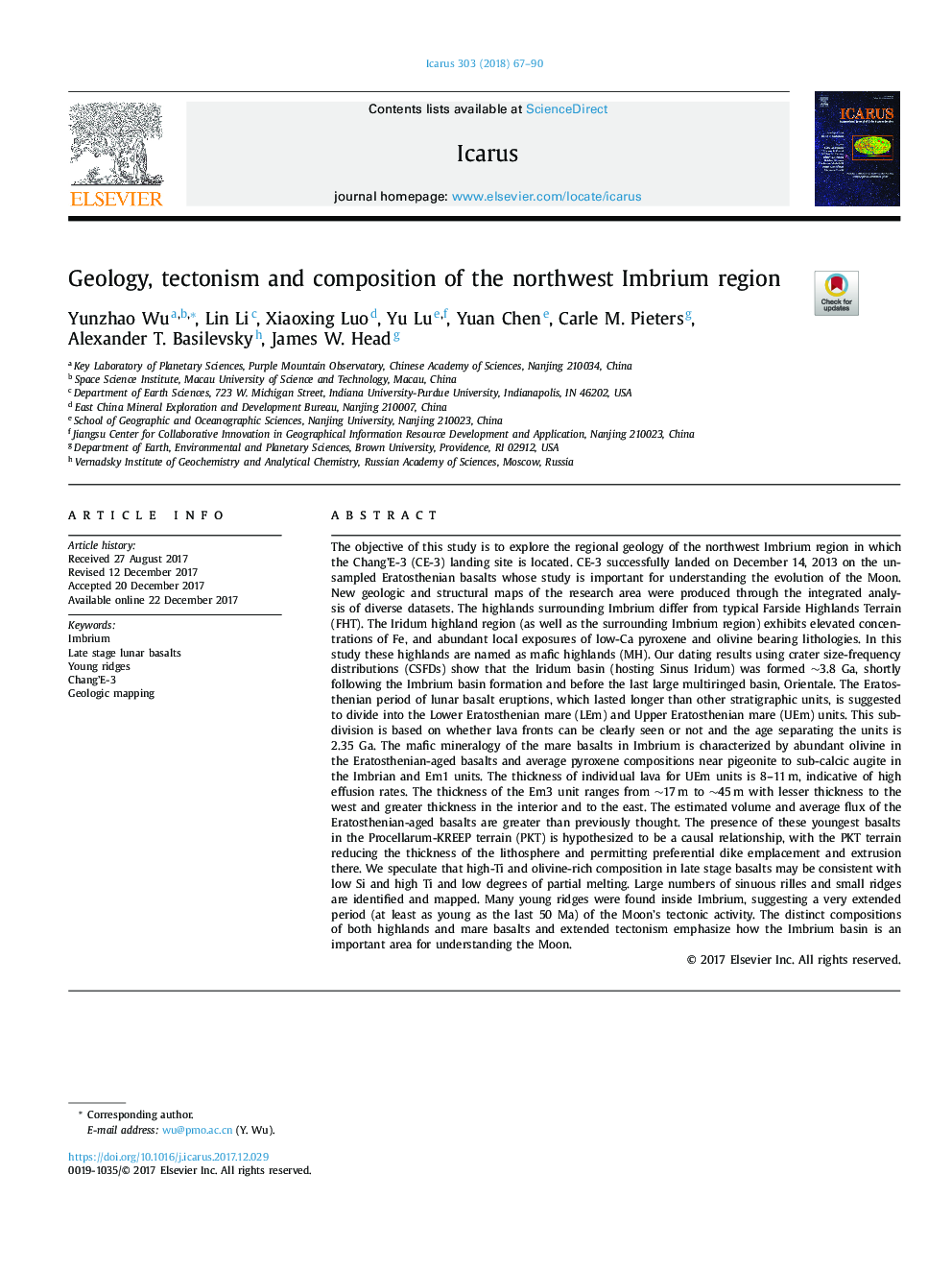| کد مقاله | کد نشریه | سال انتشار | مقاله انگلیسی | نسخه تمام متن |
|---|---|---|---|---|
| 8134414 | 1523488 | 2018 | 24 صفحه PDF | دانلود رایگان |
عنوان انگلیسی مقاله ISI
Geology, tectonism and composition of the northwest Imbrium region
دانلود مقاله + سفارش ترجمه
دانلود مقاله ISI انگلیسی
رایگان برای ایرانیان
کلمات کلیدی
موضوعات مرتبط
مهندسی و علوم پایه
علوم زمین و سیارات
علوم فضا و نجوم
پیش نمایش صفحه اول مقاله

چکیده انگلیسی
The objective of this study is to explore the regional geology of the northwest Imbrium region in which the Chang'E-3 (CE-3) landing site is located. CE-3 successfully landed on December 14, 2013 on the unsampled Eratosthenian basalts whose study is important for understanding the evolution of the Moon. New geologic and structural maps of the research area were produced through the integrated analysis of diverse datasets. The highlands surrounding Imbrium differ from typical Farside Highlands Terrain (FHT). The Iridum highland region (as well as the surrounding Imbrium region) exhibits elevated concentrations of Fe, and abundant local exposures of low-Ca pyroxene and olivine bearing lithologies. In this study these highlands are named as mafic highlands (MH). Our dating results using crater size-frequency distributions (CSFDs) show that the Iridum basin (hosting Sinus Iridum) was formed â¼3.8 Ga, shortly following the Imbrium basin formation and before the last large multiringed basin, Orientale. The Eratosthenian period of lunar basalt eruptions, which lasted longer than other stratigraphic units, is suggested to divide into the Lower Eratosthenian mare (LEm) and Upper Eratosthenian mare (UEm) units. This subdivision is based on whether lava fronts can be clearly seen or not and the age separating the units is 2.35 Ga. The mafic mineralogy of the mare basalts in Imbrium is characterized by abundant olivine in the Eratosthenian-aged basalts and average pyroxene compositions near pigeonite to sub-calcic augite in the Imbrian and Em1 units. The thickness of individual lava for UEm units is 8-11â¯m, indicative of high effusion rates. The thickness of the Em3 unit ranges from â¼17â¯m to â¼45â¯m with lesser thickness to the west and greater thickness in the interior and to the east. The estimated volume and average flux of the Eratosthenian-aged basalts are greater than previously thought. The presence of these youngest basalts in the Procellarum-KREEP terrain (PKT) is hypothesized to be a causal relationship, with the PKT terrain reducing the thickness of the lithosphere and permitting preferential dike emplacement and extrusion there. We speculate that high-Ti and olivine-rich composition in late stage basalts may be consistent with low Si and high Ti and low degrees of partial melting. Large numbers of sinuous rilles and small ridges are identified and mapped. Many young ridges were found inside Imbrium, suggesting a very extended period (at least as young as the last 50 Ma) of the Moon's tectonic activity. The distinct compositions of both highlands and mare basalts and extended tectonism emphasize how the Imbrium basin is an important area for understanding the Moon.
ناشر
Database: Elsevier - ScienceDirect (ساینس دایرکت)
Journal: Icarus - Volume 303, 15 March 2018, Pages 67-90
Journal: Icarus - Volume 303, 15 March 2018, Pages 67-90
نویسندگان
Yunzhao Wu, Lin Li, Xiaoxing Luo, Yu Lu, Yuan Chen, Carle M. Pieters, Alexander T. Basilevsky, James W. Head,